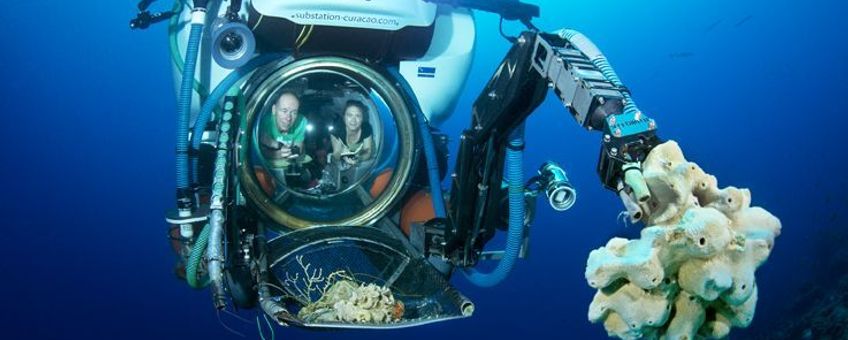
Zand, koraalduivel en cyanobacteriën in diepe riffen van Bonaire
Bericht uitgegeven door Dutch Caribbean Nature Alliance (DCNA) [land] op [publicatiedatum]
Onderzoekers van IMARES Wageningen UR daalden tot 250 meter af in de zee bij Bonaire om het fascinerende ecosysteem van het diepe rif en zijn unieke biodiversiteit te onderzoeken. Terwijl de ondiepe Zuid-Caribische riffen bekend staan om hun biodiversiteit, is er weinig bekend over de planten en dieren van de diepe riffen. De onderzoekers troffen tot ongeveer 45 meter diepte koraal aan, en tussen 50 en 90 meter een zanderige zone bedekt met cyanobacteriën. Dieper dan 90 meter zagen ze naast zand ook stukjes fossiel rif. Tot 165 meter diepte troffen ze de invasieve koraalduivel aan. Tijdens de expeditie verzamelden de onderzoekers monsters van onder andere sponzen, weekdieren en zacht koraal. Taxonomen van het Naturalis Biodiversity Center in Leiden gaan helpen met het determineren ervan; waarschijnlijk worden hierbij ook nieuwe soorten voor de wetenschap ontdekt.
Lees verder in het Engels.....
Under the banner of the Bonaire Deep Reef Expedition I, from May 30th to June 1st 2013, the deep reef of Bonaire was explored by researchers from IMARES Wageningen UR. The aim was to document this fascinating ecosystem and its unique biodiversity using cameras and collecting biological specimens. The shallow reefs of the Southern Caribbean are considered a biodiversity-hotspot, an area with exceptional diversity of plants, animals and ecosystems, yet surprisingly little is known about the flora and fauna of the deep reefs. The Dutch Ministry of Economic Affairs commissioned the research institute IMARES to study the deeper reef as part of the Exclusive Economic Zone management plan for the Dutch Caribbean.

IMARES’ researchers Erik Meesters and Lisa Becking boarded the submarine “Curasub” owned by the Curaçao Sea Aquarium and descended to depths of 200 to 250 meters at three locations on Bonaire: the Town pier, the Salt pier and the Te Amo pier. The researchers found that coral reefs extend until approximately 45 meters. The reef zone is followed by a sandy zone from 50 to 90 meters depth covered by a cyanobacterial mat. The cause of this ‘cyano-mat’ remains unclear and warrants further investigation. At depths below 90 meters, sand dominated the scenery. There were, however, also patches of fossil reef which must have formed during previous ice ages when the sea level was much lower than it is today. By providing hard substrate, these fossil reefs provided oases of biodiversity in a desert landscape of sand.
Special attention was paid to the invasive Lionfish (NL: koraalduivel). Between depths of 80 to 115 meters Lionfish were seen sporadically in schools of 10 to 20 individuals clustered together, but individuals or pairs of Lionfish were observed as deep as 165 meters, often swimming exposed above open stretches of sand.
Besides biological discoveries the researchers also discovered some archaeological objects, such as an 18th century Spanish olive urn.
During the submersible dives examples of sponges, soft corals, gorgonians, echinoderms, fish, and mollusks were collected. These will be identified with the aid of taxonomists at Naturalis Biodiversity Center and the laboratory at Naturalis will generate “DNA-barcodes” to facilitate future identification. This work is likely to result in the identification of several species new to science. Information on the deep reef habitat structure and biodiversity is essential to adequately protect the ecosystem and construct sustainable management plans. In order to protect biodiversity, it is essential to have a good understanding of what is down there and what processes keep it in place.
See the page Exploring Bonaire’s Deep Reefs at dcnanature.org for more information.
This article was also published in BioNews May 2013 edition, DCNA
Text: Lisa Becking, IMARES Wageningen UR
Photo: Barry B. Brown, Substation Curaçao
Nederlandse inleiding: Sara Mulder, De Natuurkalender
